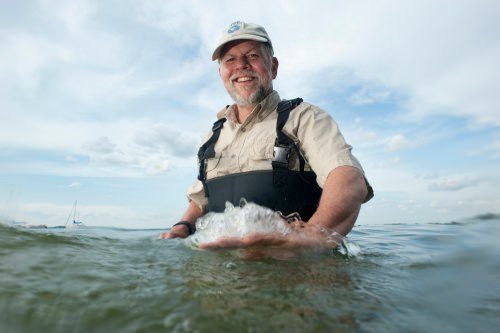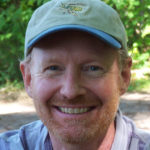All hands on deck to understand, predict, prevent abrupt ecological change
In 2011, Lake Erie turned into a toxic pea soup. One-sixth of the lake harbored a thick and deadly algal bloom that killed fish, closed beaches and struck a blow to Toledo, Ohio’s tourism industry. The bloom was three times larger than any algal bloom ever recorded there.
Then, in 2014, toxic algae suddenly contaminated Toledo’s water supply, preventing half a million people from consuming, cooking or bathing with their tap water.

Stephen Carpenter, shown in Lake Mendota, has conducted experiments to understand what drives algal blooms and similar disruptive environmental shifts. Photo: Jeff Miller
The contamination was forecast by ecologists in 2011, said Stephen Carpenter, newly retired as director of the University of Wisconsin–Madison Center for Limnology, at a recent campus symposium centered around a new effort to understand, predict and prevent these kinds of abrupt ecological changes.
That’s because increased agricultural runoff — which dumps nutrients that support algae, like phosphorous, into lakes — has combined with climate change (warmer waters) in recent years to produce blooms that are larger, more frequent and possibly more harmful. Ecologists have spent years examining the warning signs, and the lasting effects.
But there is still much they don’t know.
“A lot of times, changes can be really fast and they surprise us,” says Monica Turner, a professor of ecology and integrative biology at UW–Madison and lead principal investigator of the new UW–Madison effort, called ACES (Abrupt Change in Ecological Systems). ACES is one of several multidisciplinary projects funded by the UW2020 initiative, and among the first selected for the competitive grant program underwritten by the Wisconsin Alumni Research Foundation.

“People are all working together,” says Monica Turner of ACES. “We study different systems using varied methods with the common goal of understanding fast, changes in the world around us.” Courtesy of Monica Turner
“It’s a generally thorny problem and we are often scrambling to react,” Turner says. “In fact, understanding abrupt change in ecological systems is among the biggest challenges in contemporary ecology.”
Abrupt ecological changes can take many forms, but they can quickly lead to changes in biodiversity, natural resources and human well-being. Ecologists like Turner and Carpenter, one of four other co-principal-investigators of ACES, have spent their careers trying to understand abrupt changes and help mitigate their most deleterious effects.
For Carpenter, that’s meant conducting whole-lake experiments to understand what drives the kinds of algal blooms and similar disruptive environmental shifts seen in places like Lake Erie and in Madison’s Lake Mendota. It has also meant conducting studies of walleye in northern Wisconsin to better understand why their numbers are suddenly declining as largemouth bass are on the rise.
For Turner, it has meant three decades studying the forests of Yellowstone National Park, since the great fires of 1988, and providing data about their recovery and their setbacks in the face of increasing drought conditions, warming temperatures, more frequent and severe outbreaks of lethal bark beetles, and more frequent and intense wildfires.
“It’s a generally thorny problem and we are often scrambling to react. In fact, understanding abrupt change in ecological systems is among the biggest challenges in contemporary ecology.”
Monica Turner
At the symposium, conducted over a half day in a sunny room overlooking Madison’s largest lake, several scientists part of or affiliated with ACES made 15-minute presentations of their work to an audience of nearly 70. Over the last 18 months, the ACES team has hired a cluster of postdoctoral researchers, with the goal of “breaking open new ideas and approaches,” Turner says.
The new researchers include Zak Ratajczak, who is using models to characterize ecological changes and identify tipping points. Jien Zhang is studying trends in U.S. crop yields since climate change and freshwater shortages pose potential threats to food production and subsequently, to the economy and human health. Allison Stegner, a paleoecologist, is studying how species respond to environmental change over geologic time, to acquire a better grasp of the effects of changes today. And Tanjona Ramiadantsoa, a postdoctoral researcher from Madagascar, is developing new methods to detect abrupt changes, using historical declines in hemlock forests across America.
The symposium included presentations from UW faculty outside of ACES but who also study abrupt changes, from monkey population shifts in Brazil in the wake of disease outbreak, to snowshoe hare declines in northern Wisconsin and the dynamics of bark beetle outbreaks in western U.S. forests.
“It’s early on but we want to show our progress and stimulate discussion,” Turner says of the symposium. “We want to build opportunities for collaboration.”
In addition to Turner and Carpenter, co-principal-investigators in the Center for Study of Abrupt Change in Ecological Systems include integrative biology Professor Tony Ives; agronomy and environmental studies Professor Chris Kucharik; and geography professor and former director of the Nelson Institute Center for Climatic Research Jack Williams.
“People are all working together,” Turner says. “We study different systems using varied methods with the common goal of understanding fast changes in the world around us.”
Tags: climate change, ecology, forestry, limnology, research







